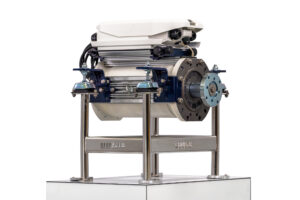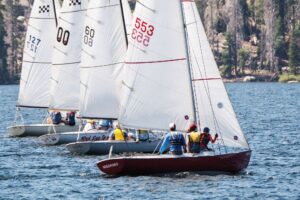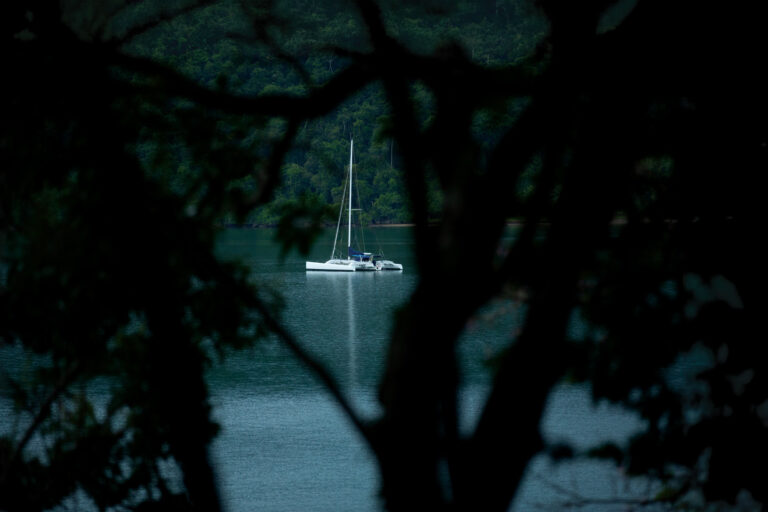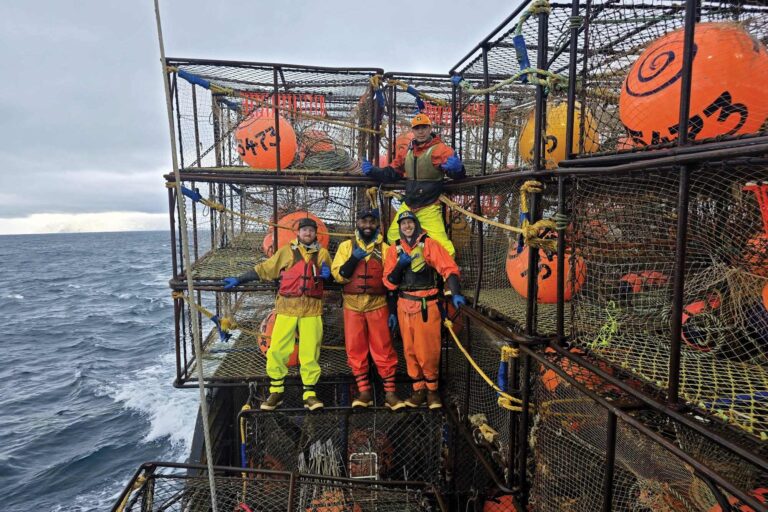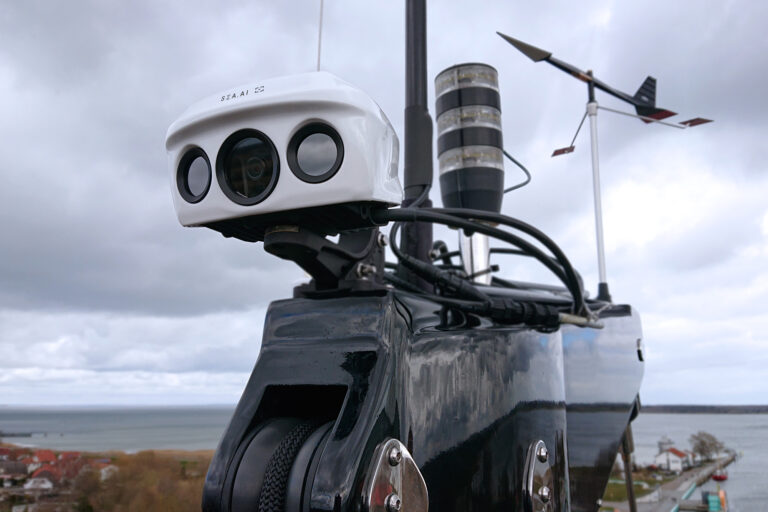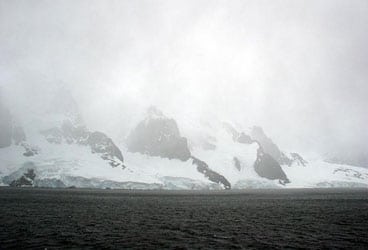
Antarctica368
.Alongside the bar at the Royal Cape Yacht Club in Cape Town, South Africa, the chat had turned to the Southern Ocean. The crowd was a mix of doers and dreamers; the stories were loud and salty. Some rang less than true. Off to the side, quiet yet watchful, was a French sailor who was known to have vast experience in “the Roaring Forties” and beyond. Our eyes met. “Ze waves and ze wind,” he said. “Remarkable. Ave you been to le sud?” His tone was reverent, different from the others.
“No,” I admitted, I hadnt been to “the south.” But I wanted to go, to see with my own eyes what now flashed in his.
Time passed. Last fall, out of nowhere, I received a fax in my office from, of all places, Antarctica. An Australian friend of mine, ex-BOC solo around-the-world sailor Don McIntyre, and his wife Margie were nearing the end of a yearlong expedition where they had lived, on ice, in an eight- by 12-foot hut. A spot had opened up on the sailboat bound from Tasmania to retrieve them. He wanted to know if I could make the trip down.
This was a once-in-a-lifetime opportunity, but there were problems. Id just come back from a years leave of absence at work, where Id exhausted favors well into the next century. I was on the verge of getting engaged to a beautiful Australian gal who also had a few paybacks coming. There was no way in the world I could do this. I faxed Donnie back: “Ill be there, no matter what.”
And now the STORM-BLAST came, and he
Was tyrannous and strong:
He struck with his o’ertaking wings,
And chased us south along.
— The Rime Of The Ancient Mariner
Two months later, queasy from nerves, land legs and a leftover easterly swell, I watched in silence as the stark hills of “Tassie” fell astern. The island is a joke to the mainland Australian — “Tasmania? Mate, I thought you said you were visiting Australia!” — but I missed the place badly the instant it disappeared. Next stop, Antarctica. All we had to do was cross 1,500 nautical miles of Great Southern Ocean.
“The Southern Ocean owes its richly deserved reputation as the worlds roughest area to one simple accident of geography. It is the only stretch of water which completely circles the globe… Since there are no land barriers to check its progress, (the prevailing) westerly wind blows uninterrupted around the world…and in doing so builds up a very large westerly sea and swell. This is why the region between 40-50º south is called the roaring forties, and between 50-60º south the screaming fifties.”
— Robin Knox-Johnston
“Beyond Jules Verne”
The furious, dependable westerlies were what lured the Tall Ships laden with commercial goods in the great age of sail; and they are what draw modern sailors such as Knox-Johnston who seek to harness their power to win races and set speed records. But it was in the name of exploration that the visionary Portuguese navigators Dias and Magellan, respectively, first rounded the southern tips of Africa (1487) and South America (1520). This posed the possibility of yet more land to the south — an idea planted by early Greek geographers who believed there must be a large landmass around the South Pole to “balance” the known land in the Northern Hemisphere.
But it was Captain James Cook who, in the course of three consecutive summer cruises between 1772 and 1775, circumnavigated the world in the high southern latitudes and crossed the Antarctic Circle (66º30S) for the first time. Though Cook did not set eyes on the continent, he did discover the antarctic islands of South Georgia and the South Sandwich group — and their wealth of marine life, particularly fur seals. It was the profit-minded sealers, in turn, who were the next to venture into the frigid Southern Ocean, and the first to set foot on the white continent of Antarctica.
By the mid-19th century, scientists and colonists had joined the southbound parade. Then, at the turn of the century, historic adventurers such as Scott and Shackleton from Great Britain risked all to become the first to reach the South Pole — a prize finally grasped by Norwegian Roald Amundsen in 1911. Later, Australias greatest antarctic pioneer Douglas Mawson left his own mark in the annals of southern exploring. It was to the site of Mawsons old base camp at Commonwealth Bay, where the McIntyres had erected their “hut” in commemoration to their countryman, that we were bound. Slowly bound. A huge high pressure system stationed over southern Australia was frying the continent and providing our crew of eight aboard the ex-BOC 60-footer Spirit of Sydney with unusual but favorable early conditions. Beating on port tack into moderate southeasterlies, we were fulfilling skipper Steve “The Nig” Corrigans initial goal of working well to the west of the rhumb line — and positioning ourselves for a favorable slant on our ultimate destination when the westerlies finally filled. Four days into the journey, three days into 1996, five miles past the 49th parallel, progress stopped. The ocean was flat and gray. The sails hung flaccid and empty. It was foggy, like an early summer morning back home on Block Island Sound. We were on the bottom edge of the fearsome Roaring Forties. We hadnt seen a breath of westerly breeze. We were utterly becalmed.
“Beyond 40 degrees south there is no law. Beyond 50 degrees south there is no God.”
— Old sailor’s adage
Days passed. Aboard Spirit of Sydney, we slipped beyond 60ºS. There was no heater. Thats right: No bloody heater. The wetness and cold were numbing. A makeshift clothesline strung over the propane oven was home to a suite of dripping off-watch mitts. Another pile baked on the engine block. Steamy breath was visible above and belowdeck. The cabin sole was soaked in condensation, a puddle of problems for those foolish enough to exit berths sans boots. I slept in doubled-up sleeping bags, wearing jacket, pile pants and long johns, and awoke shivering. I pulled on a watch cap and went back to bed.
The ice was here, the ice was there,
the ice was all around:
It cracked and growled, and roared and howled,
Like noises in a swound!
— The Rime Of The Ancient Mariner
The aluminum-hulled Spirit of Sydney, in addition to her outstanding and natural powers of refrigeration, was in excellent condition after a recent, extensive refit. Originally built for Australian Ian Kiernan to a Ben Lexcen design for the 1986-87 solo BOC race, the interior plan had been converted to fit the needs of a full crew. Water-ballast tanks had been replaced by a series of pipe berths and snug, bunk-bed-style settees. The overall effect, especially when going forward, was reminiscent of certain belowdeck scenes in the German U-boat movie Das Boot. At the foot of the companionway, someone had erected a tacky Christmas tree music box in honor of the season.
For all this luxury, our passage down the fifties had been a chilling descent. A 15-knot west-southwest wind, accompanied by thick cloud on the horizon but clear skies above, greeted us at 51ºS. The sailing was crisp and fast. By 54ºS, the sun was gone. The lower boundary on our favorite daily weather fax map abruptly stopped at 55ºS. As we tracked our progress for that waypoint, there was a sensation of sailing toward The Edge.
We should have been so lucky. The plummeting seawater-temperature thermometer, registered in degrees Celsius, could have been a misery meter. Around 56ºS it dropped several degrees in 24 hours, to a new low of 3ºC (37ºF). We had apparently entered the Antarctic Convergence Zone, where the cold, dense antarctic waters meet the warmer subtropical seas. It would eventually bottom out just this side of freezing. On deck, begloved and begoggled, no one needed reminders to clip on his harness.
“And now there came both mist and snow, and it grew wondrous cold: And ice, mast-high, came floating by, as green as emerald…
“At length did cross an Albatross, through the fog it came; as if it had been a Christian soul, we hailed it in Gods name.”
— Samuel Taylor Coleridge, “The Rime Of The Ancient Mariner”
The mighty albatross (“sea gulls on steroids,” said one comic) were by now old friends; the cold, misty fog a familiar nemesis; but where was the ice? On Spirits voyage a year earlier to drop off the McIntyres, the northernmost iceberg was spotted at 53ºS — a waypoint wed put hundreds of miles astern, with nary a berg in sight. “Youre going to go wild when you see the first ice,” said The Nig. “And youre going to be amazed how close it was before you saw it.”
Visibility was poor, but there was consolation. The daylight hours lengthened; at 62ºS it was dark less than four hours each night. And wed caught another break. The high that had stymied us early on drifted south too and, as a farewell gift, it blasted us with three days of 30-knot northwesterlies. We scurried over the 60th parallel running hard wing and wing with a deeply reefed main and poled-out staysail, notching a string of 200-mile-days.
The 0300-0600 watch on the eighth day was outstanding. Some 120-miles west of the rhumb line we jibed onto starboard to gain the favored tack, unfurled the headsail and staysail and shook the reefs out of the main. A dusting of snow settled on deck, and a half-dozen snowy petrels flittered in the sail exhaust. With spray flying and Spirit creaming along at 12 knots on a wicked beam reach, it was a Southern Ocean scene. To punctuate it, five hours later came the cry: “Iceberg!” Well to weather, long and angular, it was a twin-peaked tower of blue. We slalomed through its downwind brash — the cubes ranged in size from microwaves to minivans — and wondered how many bergs lay ahead. Reassuringly, it had popped up on radar like a blemish on prom night. As 63ºS, we were 600 miles south of the first sighting a year before.
The next night, at the tail end of a wearing watch, my watchmate Mary Ann Stresau said, “What we need are Show Tunes!” With freezing rain plinking off the hood of my jacket for accompaniment, she broke into a painful medley from Oklahoma. Mary Ann, an American, is a longtime friend of the McIntyres who had cruised to Australia with her husband. She is a good sailor. She is a bad singer. I recorded the moment in my journal: “She asked me what I thought. I told her she sounded awful. She asked me if I was a music critic and I told her I knew what I liked. She told me shed stop if I was really serious. I said, Please! Stop! There was almost the sound of a splash. It wouldnt have been me.”
Finally, just before reaching the Antarctic Circle and 100 miles from Commonwealth Bay, we copped our first true gale. The anemometer recorded a steady 35 knots, but it felt like much more. The Nig attributed it to the sheer pressure of the moisture-laden air. “Its like 40 in the Atlantic or 50 in the tropics,” he said. “More force is needed to move this air.” I wrestled with the science but the evidence was unimpeachable. We were there.
“Good to see ya. Where are the sausages?”
— Don McIntyre’s welcome speech to Spirit ‘s crew,
Commonwealth Bay, Antarctica — January 9, 1996
We forgave Don his cravings. It had been a long time since hed fired up the barbie. A cruising man at heart, hed roamed the Pacific in his beloved 30-foot Skye until his ambition for more adventure overwhelmed his wallet and he sought highly creative methods to finance his dreams. His wife Margie dropped her nursing career and, with $5,000 to their names and a small marine supply business to fall back on, Don put in motion his plan to race the 1990-91 BOC Challenge.
He scraped and borrowed, and built a 50-footer that he named with his banker in mind: Sponsor Wanted. At the midway point of the race he found support from an Australian baked goods company and the boat became Buttercup. He sailed to a terrific second-place finish in his class, and afterward his backers sponsored a voyage to Antarctica. While there, bitten by the adventure bug, he envisioned a grander scheme — to lead a completely self-supporting, yearlong husband-and-wife expedition to the ice. Expedition Icebound was under way. The McIntyres sought and received permission from the Australian Antarctic Foundation to camp near Mawsons Hut; set up an education program with Australian and New Zealand schools; found partial sponsorship from communication giant COMSAT; secured film and book contracts; and headed south.
The McIntyres are imbued with the same entrepreneurial spirit that enabled Magellan and Cook and others to find funding for their explorations. In fact, theyd chartered half-a-dozen berths aboard Spirit for our voyage, and have begun a commercial adventure-travel concern with the boat for future trips. The Southern Ocean remains open for business. On our last day in Antractica, a QANTAS jet day-tripping from Sydney flew low over the McIntyres camp on a regularly scheduled tourist flight. During our layover at Commonwealth Bay, we were visited by a Soviet research vessel-turned-New Zealand tour boat on an extended luxury cruise. In the southern summer Antarctica is still lonely, but youre not necessarily alone.
Months earlier, that had not been the case. The McIntyres endured the hellish conditions of the long, dark winter when their eight- by 12-foot prefab hut was completely inaccessible. They were tested and survived wind storms that neared 200 knots, and they were rewarded with a year of undescribable experiences.
While preparing for the return voyage, over a four-day stretch of 50-knot winds, we received a taste of the wild weather they faced. When it finally eased, we were out of there. I felt privileged to have witnessed the wildlife, the raw country, the amazing vistas, and I was damned glad to be headed home.
“He sent the others below to get some warmth and sleep in the reindeer-skin bags while he kept a sharp lookout for ice. I steered; (Shackleton) sat beside me… By midnight the sea was rising, and every other wave that hit her came over, wetting us through and through. Cold and clear, with the Southern Cross high overhead, we held her north by the stars…”
— F.A. Worsley, Shackletons Boat Journey
he most remarkable Southern Ocean voyage ever recorded occurred in 1916. Sir Ernest Shackleton and a crew of 28 were en route to the antarctic when their square-rigger Endurance was beset by ice and crushed. The sailors spent five months drifting on an ice floe before it too broke up beneath them and they were forced to take to three lifeboats, reaching remote Elephant Island. From there, Shackleton, his trusted captain Frank Worsley and a crew of four set out on a creaky 22-footer bound for a whaling station on South Georgia Island — 800 miles away.
A copy of Worsleys account of the nightmare journey, a passage from which is excerpted above, was with us onboard Spirit. When anyone dared complain, The Nig recited specific incidents of terror and triumph as if they were biblical lore: “Furthermore,” hed conclude, “Shacks didnt have GPS.”
In fact, we had our own “Shacks” onboard in the personage of David Nelson, an accomplished Alpinist, new to offshore sailing but quickly proving himself a natural. So too was his watchmate Cameron Aird, a commercial diver from New Zealand with scant previous experience whod taken the moniker “Mawse” after Douglas Mawson. Used to hard work in rugged wilderness, “Shacks” and “Mawse,” our A-Team, greeted each watch with high fives and a hunger to take on any task.
Mawse was also proving to be a fine sea cook, and he perfected a thick pumpkin soup he called “hoosh,” the name of a staple mush aboard Shackletons ships and a delicacy that prompted Worsley to wax lyrically: “In cooking, the aroma of this ambrosia rose as incense to the gods.” Our own hoosh had much the same effect, even though I had burned my mouth crispy weeks earlier. My vice was an insipid Australian cocoa called Milo, which tasted like a single Hershey Kiss boiled in hot water. I was addicted to the heat of the stuff, and couldnt get enough of its scalding ride from tongue to gullet. Food and drink had become more important for their warmth than their flavor.
The fair breeze blew, the white foam flew,
The furrow followed free;
We were the first that ever burst
Into that silent sea.
— The Rime Of The Ancient Mariner
ith a batch of hoosh on the stove and a building southeasterly gale, we had a fast start to our northbound leg, registering 176 miles in the first 18 hours of sailing. It appeared that the unusual string of northerlies in the latter part of the first leg had blown the bergs and pack ice fortuitously out of our path. But the first nights clear, chilled sunset saw us weaving through a massive ice field whose grand monoliths were Stonehengian in shape and assemblage. Backdropped by a fiery horizon and capped by a pastel orange-blue ceiling, it was worth every minute it had taken to get there.
“At midnight…the wind was north-northeast, Force 7. Down to topsails now, her upper and lower yards naked, gleaming yellow like great bones in the moonlight, she was a terrible wild stranger to us. At the wheel a Swede and a Dane were fighting to hold her as she ran 13 and 14 knots in the gusts. I knew then that I would never see sailing like this again. When such ships as this went it would be the finish. The windbelts of the world would be deserted and the great West Wind and the Trades would never blow on steel rigging and flax canvas again.”
— Eric Newby, The Last Grain Race
n 1938, 18-year-old Eric Newby signed on as apprentice aboard the four-master Moshulu for a voyage from Europe to Australia and back by way of the Southern Ocean — outward by way of the Cape of Good Hope in ballast and homeward around Cape Horn with a cargo of grain. A dozen or so ships were still active in the trade, and they raced annually to make the shortest passage home. Newby was right about one thing: It was the swan song for the Tall Ships. But it was not the end of outrageous southern sailing. In 1994, co-skippers Robin Knox-Johnston and Peter Blake drove their 92-foot catamaran Enza New Zealand to a new world record for the fastest circumnavigation of the planet with a time of 74 days, 22 hours. Deep in the Southern Ocean, daily runs of 450 miles were not uncommon. Their average speed was almost 15 knots.
Following the same route that Newby sailed 46 years earlier, Enza reached the halfway point of the trip in 32.5 days (Moshulu, with the second fastest time that year, took 82); and covered the second half in 42.5 days (the fastest time for a Tall Ship along that course was Cutty Sarks voyage of 71 days in 1888).
Wed had an easy passage south, but now it was our turn to realize what lured generations of sailors before us. With the barometer at 975 millibars and plunging, and fueled by a 35- to 45-knot gale, we crossed 60ºS in three fast days while again putting a heap of westing in the bank. It seemed odd to sail north for the sun and warmth, and the clockwise-spinning low-pressure systems added to the novelty. Between the weatherfax and a radio schedule with the Casey Australian antarctic research station, we were receiving dependable forecasts. The lows were stacking up to our west like jets over OHare. With apprehension and anticipation, we pressed forth toward an inevitable rendezvous.
The westerlies, when they came, did not disappoint. In the course of three full gales on the homeward board, we faced winds that topped out near 60 knots and seas down which one could ski. We were on the right side of two of the three lows, which brought winds abaft the beam and long, wicked surfs up to 20 knots. Spirit reveled in the rough weather shed been built for.
Snapshots in the minds eye are the souvenirs of any long voyage. From those miles I have these memories: steering on a dark night, hitting an unseen wave just so, the shudder of the boat and the dreadful silence before the deluge of cold spray; driving through an ocean of phosphorescence, disoriented by the celestial seaway juxtaposed against a black, starless sky; the eerie light of an aurora; a brilliant double rainbow; weird dreams.
Two days out from Tasmania, smack-dab in the Roaring Forties, we had a fire drill. A building breeze, an uncontrolled jibe and suddenly a bunch of us were on deck striking the main. The job done, my sweat freezing, I looked around at what had to be one of the most inhospitable scenes on the planet. It was good to be there.
————————————————————————
Executive editor Herb McCormick spent 1994-95 on a leave of absence from Cruising World. During that time he was the media relations manager for the BOC Challenge, and in that role traveled around the world handling the press for that legendary event. It was also there he met Carole Marsh, whom he married four months after his trip to the ice. For more information on future Spirit of Sydney sailings contact McIntyre Marine at (61)(2)9979 8525 (phone) or (61)(2)9979 8535 (fax).


